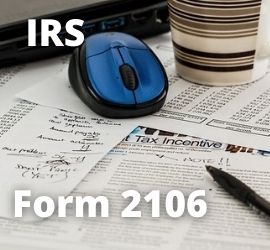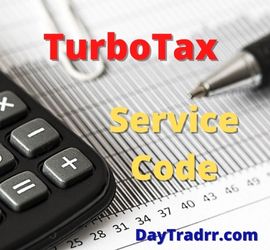What Is IRS Form 2106 – Employee Business Expenses?
 IRS Form 2106 lets individuals deduct ordinary and necessary expenses from federal taxes incurred performing a qualified trade or profession.
IRS Form 2106 lets individuals deduct ordinary and necessary expenses from federal taxes incurred performing a qualified trade or profession.
IRS Form 2106 is the Employee Business Expenses supplemental tax form distributed by the Internal Revenue Service (IRS). It is used by employees to deduct what the IRS calls ordinary and necessary expenses related to their jobs. Ordinary expenses are generally considered common and accepted in a particular line of business. Necessary expenses are those that are required to conduct business.
Starting in the tax year 2018, unreimbursed employee business expenses can no longer be claimed as a tax deduction for the majority of taxpayers. Currently, the only people who can use Form 2106 are Armed Forces reservists, qualified performing artists, fee-based state and local government officials, and employees with impairment-related work expenses. Before 2018, employees with unreimbursed work expenses could use Form 2106 to claim those expenses. They were listed as miscellaneous itemized deduction.
Taxpayers used to have two options for claiming job-related expenses as a tax deduction. They could take an above-the-line deduction or claim an itemized deduction for unreimbursed job expenses for W-2 income. Tax reform eliminated the itemized deduction option when the Tax Cuts and Jobs Act (TCJA) went into effect in 2018.
Who Can File IRS Form 2106 – Employee Business Expenses?
Before 2018, any employee with unreimbursed work expenses could use Form 2106. It let them claim those expenses as a miscellaneous itemized deduction. However, after 2018, only the following taxpayers can use Form 2106:
- Armed Forces reservists – You’ll also qualify for this adjustment to income if you were a member of the Reserve of the Air Force, Army, Coast Guard, Marine Corps, Navy, Army National Guard, Air National Guard, or Public Health Service Reserve Corps. You can deduct expenses for traveling more than 100 miles from your main home. Your deductible expenses are limited to the federal per diem rates for the city you’re traveling to
- Qualified performing artists – Performing artists qualify if they provide services in the arts for two or more employers and receive at least $200 in wages from those jobs. Your job-related expenses must be more than 10% of the income you earned from these jobs, and your AGI must be $16,000 or less—without regard to this deduction—as of the 2019 tax year, the return you’ll file in 2020
- Fee-basis state or local government officials – Your job-related expenses are also deductible if you were a government official who was compensated entirely or partly on a fee basis.
- Employees with impairment-related work expenses
IRS Form 2106 – How to File
There are two parts to Form 2106. Part I is for all employee business expenses and reimbursements. This part then helps you determine which expenses are eligible for a tax deduction. These include vehicle expenses, parking, toll, transportation charges, and other business expenses. The taxpayer should then include any reimbursements made by the employer.
- Part I – Form 2106 will walk you through which numbers to enter on which lines. Part I of the form is where you enter the business expenses you had throughout the year. Then determine whether or not you were reimbursed for those expenses. There are two separate columns. Column A is for business expenses like transportation and lodging. Column B is for meals and entertainment. Then, you total the expenses you’ve listed in each column.
- Part II – is all about vehicle expenses. If you didn’t have any vehicle expenses, you can skip this section of the form. If you used your own car for business and you’re claiming business expenses, you disclose information about your vehicle in Section A. Section B covers the mileage rate that applies to the miles of business travel you’re deducting. Expenses like gas and insurance for your car, or rental car expenses if you rent a car on a business trip are covered in Section C. Section D is where you adjust your deduction according to the depreciation of your vehicle during the tax year. You only need to fill out Section D if you owned the vehicle used for business expenses and you’re completing Section C for that vehicle.
Vehicle expenses – Two choices
- Standard mileage rate – They can use the standard mileage rate, which means multiplying the IRS mileage for the tax year by the number of business-qualifying miles driven. The mileage rate factors in gasoline and repair expenses, plus wear-and-tear on the average car. For 2021, it is set at 56 cents per mile (down from 57.5 cents in 2020).
- Itemize actual expenses – The second method is to calculate actual expenses. These include gasoline, oil, repairs, insurance, registration, and depreciation which is factored with the use of a table in the instructions. You are not able to deduct interest on car loans. There are also limits on car valuations. Whether you used standard mileage or actual expenses, expenses incurred commuting to and from work are not considered eligible business expenses.
Where to Get IRS Form 2106
Form 2106 is available from the IRS online. You can complete it online, download it, or print it out and fill it in by hand. There was another version of the form.
Form 2106-EZ – Unreimbursed Employee Business Expenses was a simplified version of the current Form 2106. It was used by employees claiming a tax deduction because of unreimbursed expenses related to their jobs. This form was discontinued after 2018 when the Tax Cuts and Jobs Act (TCJA) went into effect.
Where to Mail IRS Form 2106
The address to which you’d mail a paper return to the IRS depends on your state and whether you’re enclosing payment. The IRS provides a link for each state on its website, telling you the address you should use.
Final Words
Consult a tax professional if you’re not sure whether you’re an independent contractor or an employee. It can be difficult to make a distinction in this profession. There’s a chance that you’re an employee, even if you think you’re not. Especially if you accept work through the Screen Actors Guild, Actor’s Equity, or the American Federation of Television and Radio Artists.
Also, any expenses you deduct from your taxes must be verified with evidence. If you don’t have the receipt, don’t list the expenses on Form 2106. There can be interest and penalties if you are audited.
Remember that any expenses you deduct from your taxes must be backed up with evidence. If you don’t have the receipt for that car you rented on a business trip or the hotel room you paid for during a conference you attended for work, you can’t enter those expenses on Form 2106. It’s also important to claim only those expenses that are business-related. So if you added a day to the end of your business trip to go visit your college roommate, the expenses from that extra day don’t count as a business expense and shouldn’t appear on Form 2106. (Source: smartasset.com)
:max_bytes(150000):strip_icc():format(webp)/ScreenShot2021-02-06at6.37.24PM-e6ebd594161f4e2dba070ffdf962076c.png)
Up Next: What Is a Private Activity Bond (PAB)?
 A PAB or Private Activity Bonds are issued by local governments to attract private investments for projects with public or common utility.
A PAB or Private Activity Bonds are issued by local governments to attract private investments for projects with public or common utility.
Private activity bonds (PAB) are tax-exempt bonds issued by or on behalf of a local or state government. There are strict rules to qualify. However, they provide special financing benefits for qualified projects. The financing is most often for joint-use projects, and the government generally does not pledge its credit. However, with little else to offer and tight municipal budgets, the PAB structure incentivizes private equity investment in public projects.
Private activity bonds not only benefit private entities but the public as well. Additionally, they provide increased infrastructure spending. Private activity bonds are sometimes referred to as conduit bonds.




